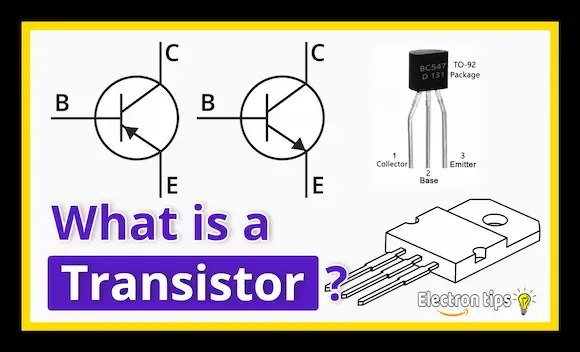 |
| How Transistor works, symbol, types , structure |
How Transistor works, symbol, types , structure, Applications
The invention of the transistor in the last century was a great revolution in the field of electronics and it is considered one of the most important inventions that contributed greatly to the development of electronics and technical devices in general.
Without the presence of a transistor it would not enable humans to manufacture computers and mobile devices and specifically processors because the processors consist mainly of a huge number of very accurate transistors, as hardly any device is currently devoid of the transistor either in one way or another, so What are the basic components of the transistor ? Transistor symbol ? Transistor terminals? and the transistor types ?
Transistor definition:
Transistor is an electronic element that belongs to the semiconductors and allows us to control the other electronic components through the so-called base, as it consists of three terminals:
Base .
Emitter .
Collector.
It is mostly made of silicone or germanium, and it is often used in signal enlargement circuits ( amplifier ..) and many other electronic circuits.
The components of the transistor :
 |
| Transistors Types |
Transistor Types:
 |
| Types of transistors |
NPN transistor :
 |
| Npn transistor symbol |
Whereas when the silicon material is grafted with a material that takes electrons, such as an aluminum atom, Al, for example, in this case the material will contain holes or holes, and we call this type Type P, meaning positive. To obtain an NPN transistor, we combine two types of Type N and a type of P. With this we get an NPN transistor, see the image below:
PNP transistor:
 |
| PNP transistor symbol |
How does a transistor work:
The transistor works to pass electric current from the collector to the radiator or emitter, but it must meet a condition, which is that it must be energized with a weak current on its base, and the larger the current entering its base, ib, the more it allows a high current to pass between the two terminals of the collector, ic, and the emitter, ie this is a working principle the transistor is very similar to the operation of a water tap.
The importance of the transistor element :
The importance of the transistor is evident in the operation, management and control of many electronic circuits. It can be used in the form of an ON-OFF switch, but its function remains in amplifying electrical signals, such as audio amplifiers and many different projects that can be created with this wonderful electronic element.
Some uses of transistors :
The transistor can perform many roles in the field of electronics and technology in general. These are some of the uses of the transistor:
Using transistors to make amplifiers and speakers.
Manufacture of microprocessors consisting of millions of transistors.
The transistor is widely used in the field of making electronic and technical devices such as smart phones, laptops, and many electrical devices.
The transistor is widely used in electronic control circuits because it allows the circuits to be controlled through an electric current in its base.

